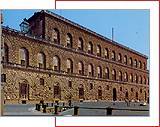Florence and the MEDICI
back to itineraries in Florence
The
Medici had a
very close relationship with Florence for more than three centuries.
They influenced the city and were influenced by her. Cosimo the
Elder, called Pater Patriae, held both public and private
power in town. So did his grandson Lorenzo, called the Magnificent.
As active merchants and bankers the Medici handled important financial
affairs with the Church and the most important European courts.
They reached the Papacy with Leo X and Clement VII, the throne
of France with Henry II's bride Catherine and Maria who married
Henry IV. The Medici patronized art, favoured the ribirth of antiquity,
developed learning and promoted science. They made Florence the
capital of a rich and powerful well respected Principate. An itinerary in search of the Medici cannot but start from the Medici Palace, built in 1444 by Michelozzo for Cosimo the Elder. In the renaissance courtyard one can see the Medici coat of arms and at the first floor visit the small, but richly decorated Chapel where Lorenzo's resemblance with the younger of the three kings emphasizes the political and civil weight of the Medici. |
|
||
|
|||
In
the nearby piazza
Signoria and Palazzo Vecchio the achievement of monarchical
power by the Medici is clearly visible. Sculptures in the square
as well as those under the Loggia, called in XVIth Century of
'the Lanzi', emphasize the might of Medici Grandukes: Bandinelli's
Hercules and Cacus , Cellini's Perseus, Ammannati's Neptune,
Giambologna's Rape of the Sabine and the Equestrian
Monument of Cosimo I. Furthermore, in the courtyard and inside
Palazzo Vecchio the visitor notice the various changes wanted
by Cosimo I and his wife Eleonora of Toledo. Giorgio Vasari and
his several assistants transformed the Palace of old Republican
regime into a great Ducal Palace , lavishly decorated with paintings
and sculptures.
Cosimo I's climax was reached when the Uffizi were built in 1560 and later Vasari was charged to link Palazzo Vecchio with the newly acquired Pitti Palace, thanks to the Corridor built in 1565 over the old shops at Ponte Vecchio. Although the Uffizi were used for the administration of the Granduchy, the top floor was turned into one of the most prestigious art collections. Buontalenti designed the Tribune as a magic jewel box containing precious items, painting and sculptures of amazing value. |
|
||
At
Pitti Palace and in
the magnificent Boboli
gardens, designed by Tribolo in 1550, the Medici lived as successful
sovereigns sorrounding themselves with high quality works of art
and really fascinating pomp. At least one of the several country
Medici villas should be visited to end the Medici tour properly,
either at Careggi, Castello, Petraia or Poggio Imperiale in the
outskirt of Florence and, in the sorroundings of the city, at
Poggio a Caiano, Cerreto Guidi, Pratolino or Cafaggiolo. |
|
||
|
|||
DOWNLOAD
Medici.pdf (59 kb)
back to itineraries in Florence








 German
German French
French Spanish
Spanish Italian
Italian Portuguese
Portuguese Czech
Czech Japanese
Japanese